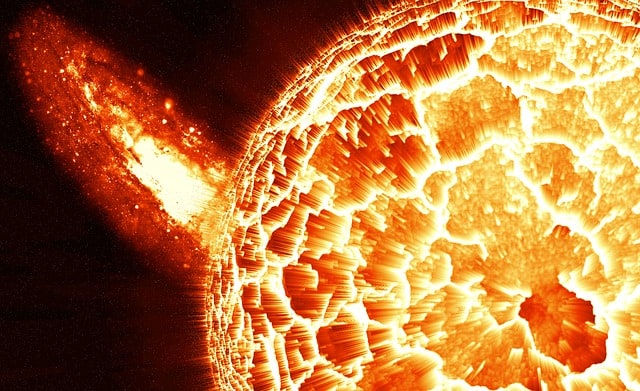Radiant Energy: How Does it Work , Examples and Interesting Facts

Energy can be potential or kinetic. Radiant energy is a form of Kinetic energy. Movement of atoms, molecules, objects, wave, and substance is connected to a Kinetic energy. Kinetic energy can be in many different forms like sound, thermal energy, motion, electric energy, etc. Radiant energy is very important for example, there would be no life on Earth without radiant energy.
The energy of the electromagnetic waves and gravitational radiation is a radiant energy. Radiant energy can travel through air, liquid, glass, space, or any other substance. It is created by changing configuration of electrons. Radiant energy can be transmitted in a vacuum environment, so the matter is not essential in transmitting radiant energy. Radiant energy is moving at a very high speed, straight line and it can be transmitted, reflected or absorbed.
Radiant energy is transmitted when the body cannot absorb it. It is the energy collected from electromagnetic radiation. This is a form of kinetic energy because the moving particles carrying heat, light, and radiation from one source to another. Electromagnetic radiation can be in many different forms, all around us. The most frequent form of Electromagnetic radiation is normal light. Even though radiant energy is created by changing configuration of electrons, Electromagnetic radiation contains just protons, but in the form of radiant energy those photons can be seen as a light or felt like a heat.
Radiant energy is one of the most interesting and the most promising research areas. It has potential to fulfill all the energy that humans need, but it should be investigated carefully. Many people are arguing that radiant energy has much more potential and that can be used on a large scale in humanity, but there is a lot of researching that needs to be done.
How Does Radiant Energy Works?
Radiant energy system was first developed by Nikola Tesla, in the 1930’s. Tesla used an antenna, stuck it up in the air to form a potential change in electrical current. Transmission of radiant energy is produced by a warm surface that gives its heat to a cooler surface. If there is a difference in temperature between two surfaces, both of them would try to equalize the temperatures.
Radiant energy is traveling through space without heating it. It only turns to heat when it is in contact with a cooler surface. Radiant energy is produced naturally. It is used mostly in the fields of solar energy, radiometry, heating and lighting, telecommunication. Electromagnetic waves are traveling through outer space, moving at the speed of light. That is happening because of the radiant energy. Electromagnetic waves as the radiant energy come into contact with particles and make them move.
Taking, for example, solar energy (a form of radiant energy), the sun retains a huge amount of radiant energy which produces electromagnetic waves. These waves are traveling through space and time until those waves come in contact with something else –let’s say our skin- our skin will move faster because of the contact with those waves. Because of the faster moving of the molecules, we feel warmer. Those waves will travel through space, without doing any work until they hit something.
There is nothing to stop those waves, so until they hit something they will travel. There are many advantages of radiant energy systems like it is very cheap to set up, and they are very practical to use it, but only in a small amount. And that is actually a disadvantage of using radiant energy system. It cannot produce a large quantity of energy. No one ever produced enough radiant energy for the family to live regularly.
Examples of Radiant Energy
Basically, anything that has a temperature has radiant energy. There are many examples of radiant energy. Two the most important examples of radiant energy are Heat and Light.
Heat- in this form of radiant energy can be included anything from a burning match to a complicated geothermal heat from the underground. There are many ways how heat can be transferred as energy, and it is radiated in temperature-responsive waves.
Light- there is many different sources of light, and all of them have radiant energy. For example, light from natural sources, sunlight, burning candle, sun’s reflection of the moon, planets is a radiant energy. Also, artificial light sources are radiant energy. For example, halogen, Led light bulbs, incandescent, neon light.
There are many examples for radiant energy, and most of them are a very important to us, and basically, they are all around us:
- Electricity
- Radio waves
- Gamma rays
- Home heating units
- Light from the Sun
- Heat from an overused computer
- Visible light
- lighting fixtures
- Emission of heat from a hot sidewalk
- Microwaves utilize radiant energy
- X-rays give off radiant energy
- Water is reflecting or absorbing radiant energy
- The light produced by a light bulb
- Ultraviolet light
- Heat created by the body can be radiant energy
- Cell phones utilize radiant energy to function
- Magnetic motor generators that utilize neodymium magnets create radiant energy
- The heat emitted from a campfire
- Heat caused by friction
- Heat emitted from a dryer
- Fixtures that convert solar energy to heat
- A window reflects radiant energy
Various Interesting Facts About Radiant Energy
Fact 1: Radiant energy can be transmitted by waves or particles, and it usually travels by electromagnetic waves.
Fact 2: Electromagnetic waves can be used for many things. Microwaves, X-rays, and lights are just some of examples of the way people use electromagnet waves.
Fact 3: Radiant energy was discovered by British chemist and physicist Sir William Crookes in the late 1800’s.
Fact 4: Radiant energy can be visible or invisible to the human eye.
Fact 5: Joules is the unit of measurement used for measuring radiant energy.
Fact 6: Soil absorbs radiant energy, and that absorption of light and heat warms seeds and roots in the soil helping the growth.
Fact 7: The reason why you can feel the heat when you when you touch it is because heat can travel in any direction, although hot air only rises up.
Fact 8: Anything that has a temperature different to the absolute zero can produce radiant energy.
Fact 9: The speed of light is the fastest than any other speed, including the sound. That means that sunlight creates radiant energy.
Fact 10: Radiant energy only travels in a straight line.
Fact 11: Radiant energy can travel in many types of matter that includes solids, liquid and gaseous.
Fact 12: Radiant energy is reflected when the body cannot absorb it.
Fact 13: Radiant energy can be absorbed, reflected and transmitted.
Fact 14: Radiant energy can move very efficiently in a vacuum.
Fact 15: The matter is not necessary for transmitting radiant energy.
Fact 16: Life on Earth wouldn’t exist without radiant energy. It is absolutely necessary for the survival of life on the planet.
Fact 17: Heating, lighting, telecommunications, are just some of examples of radiant energy. There are many more important processes.
Fact 18: It is possible that the scientists can see the radiant energy as photon energy because of the conceptualization of electromagnetic radiation.
Fact 19: The solar energy collector is a man-made radiant energy.
Fact 20: Radiant energy is significant in a lot of areas especially in telecommunications over long distances and through wireless networks, heating technology, radiometry, and lighting.
Radiant energy is all around us, travels through space and time. It is up to us to learn and research more about it. So far radiant energy showed potential that if used in the right way can produce energy that is more than useful for a human race.






